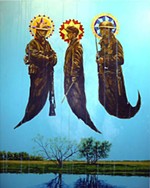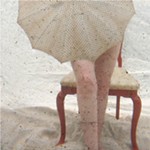‘Beverly Penn: Weeds’
Beverly Penn's sculptures of weeds in bronze, brass, steel, and nickel are not only stunningly beautiful, they also help us redefine the nature vs. technology dichotomy
Reviewed by Nikki Moore, Fri., Dec. 15, 2006

"Beverly Penn: Weeds"
D. Berman Gallery, through Dec. 23
"But a weed is simply a plant that wants to grow where people want something else. In blaming nature, people mistake the culprit. Weeds are people's idea, not nature's." – Author unknown
Situating her primary area of interest at the junction between nature and civilization, Beverly Penn frequently uses phrases like "the sacrifice that accompanies the advances of industrial and post-industrial times" to describe the issues in question in her artwork. Yet while Penn's wax-cast sculptures of weeds in bronze, brass, steel, and nickel may be stunning examples of the tension between our increasingly technologized world and the global resources we're draining and replacing in that advance, there's something in Penn's study of weeds, rather than flowers or plants, that essentially recasts these past explanations of her projects. We tend to think of weeds as nature unhinged, as wilderness amid civilization, as sin in the soil. Quotes like Robert M. Pyle's "But make no mistake: The weeds will win; nature bats last," illustrate the inside vs. outside, cultivated vs. natural dyads we use to even think about weeds. Yet as noted above, weeds are our ideas, not nature's. So with no real distinction between weeds and any other plant you might think of other than the ones we invent, weeds are as culturally constructed as the bar codes and measuring devices Penn uses to illustrate their differences. Thus, Penn's beautifully crafted weeds may look as if they allude to something wild that has been tamed, measured in time, and gilded into the confines of an unnatural technology, as in Twelve Months Time (2005), but in fact, this sculptural graph of a Pittisporum plant in bloom and recession is all construct. It is entirely man-made, from the idea of weed to the technology that holds the recast plants themselves.
None of this redescription or redefinition takes away from the tiny sublimity of Penn's work. As each thorn, each opening bud, each plant going to seed, is replicated in fine metal sculptures, the artist's intricate metalsmithing skills are abundantly clear. Even so, the tensions change. Penn's work no longer illustrates the difference between technology and nature but rather how both are tools from the same toolbox: constructs we use and invent to order the world according to our preferences and our tendencies. As work like Beverly Penn's helps to, at least, resituate and, at most, redefine the nature vs. technology dichotomy, it is interesting to think how simple redefinitions might help us rethink other basic dyads, like man vs. woman, foreigner vs. native, even legal warfare vs. terrorism. If "weeds are people's idea," then what else might we be oversimplifying?










